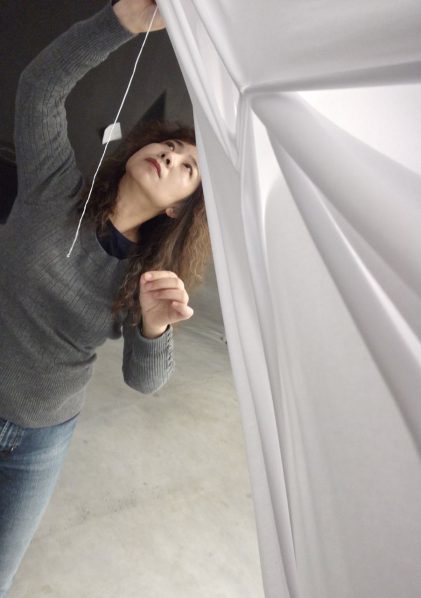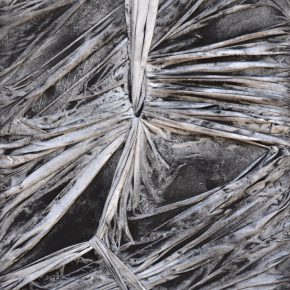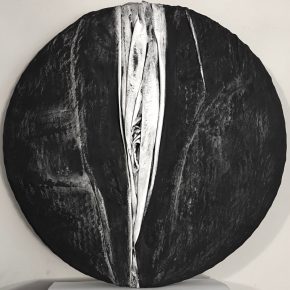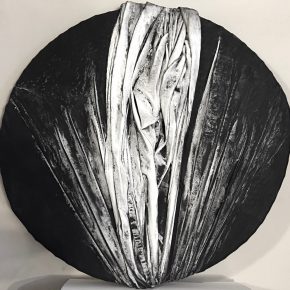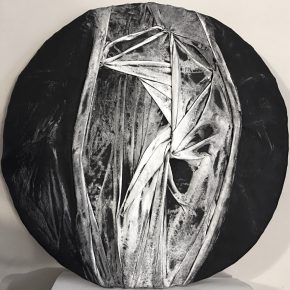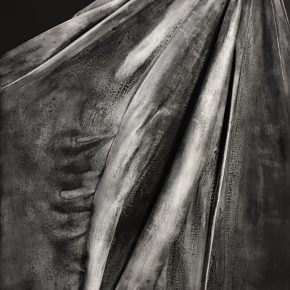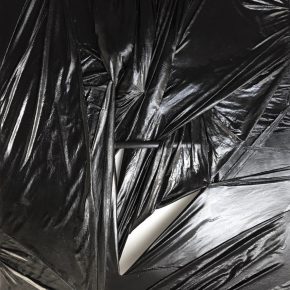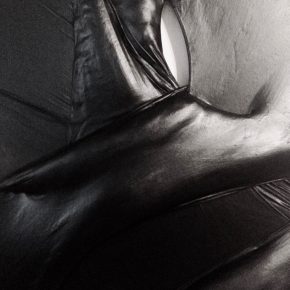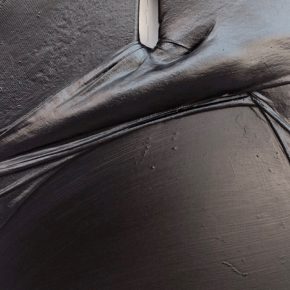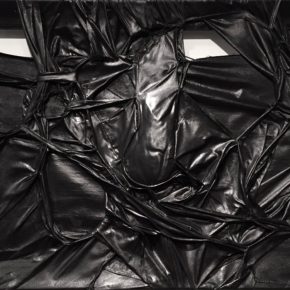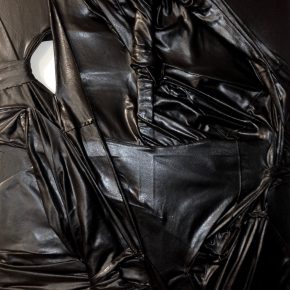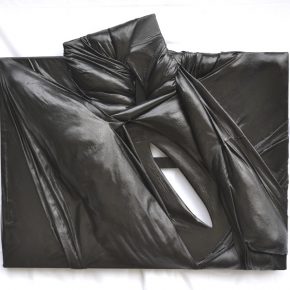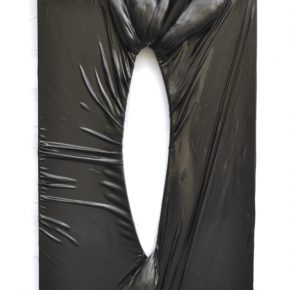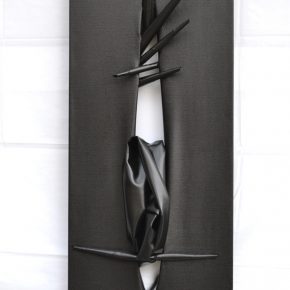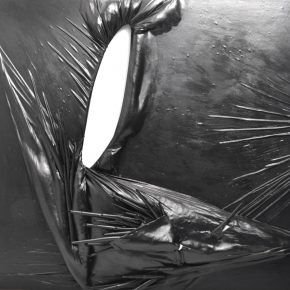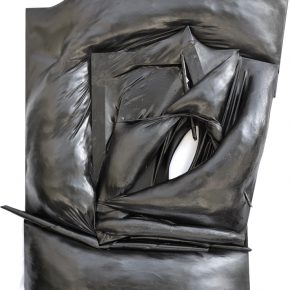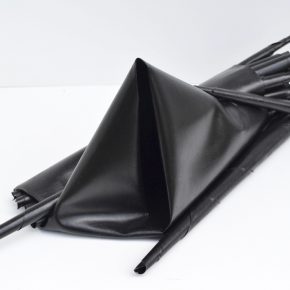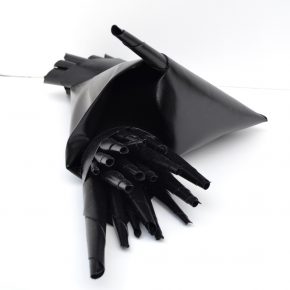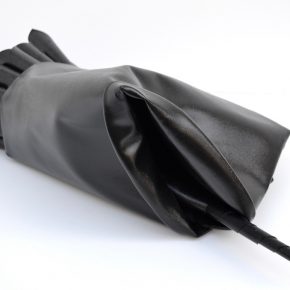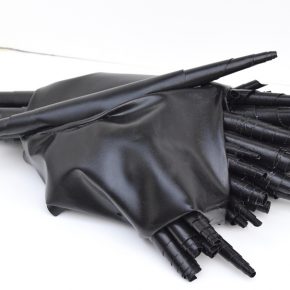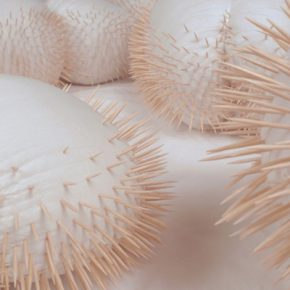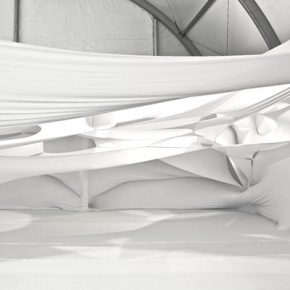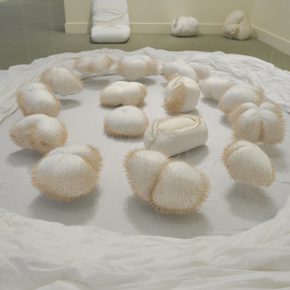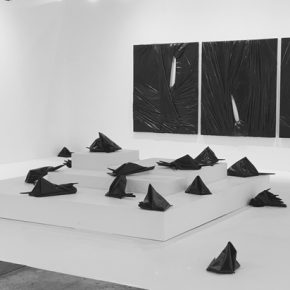Stella Zhang
Stella Zhang: 0-Viewpoints
By Mary-Ann Milford-Lutzker
Stella Zhang (b. 1965, Beijing) is schooled in the classical traditions of Chinese art and the academy. She lived in China for the first 20 years of her life, then moved to Japan for the next ten years, and now is living in California. She is the daughter of Zhang Ping (b. 1934), noted painter and calligrapher, and grew up under his tutelage, learning from him the time-honored way of holding the brush. As a rest-less soul her interests lay in exploring the new and different forms of visual expression that she was exposed to in art school. Today her art is expressed in the visual language of the contemporary global art world, where art is no longer neatly categorized by national boundaries, nor confined by borders, frames, or museum spaces. Performance, installation, and site-specific art demand different responses from viewers who are now required to interact with the ideas and concepts of artists. Stella Zhang is very much a part of this exciting and challenging new art world, as evidenced by her art that is exhibited throughout the world.
The confidence with which Stella Zhang works and expresses herself comes from growing up in a scholarly and artistic environment where she learned calligraphy and brush painting from the time she was a small child. Her father, Zhang Ping, was for many years a highly esteemed professor at the Chinese Academy of Fine Art (CAFA) in Beijing. He sent his young daughter to the CAFA High School for promising artists, where she continued to study and practice calligraphy, and to paint in the classical tradition every day for four years, before entering CAFA as an undergraduate.
One could say that she was born to be an artist, essentially it is in her DNA, she had no choice—yet she is a restless spirit. Frustrated by the essential conservatism of the Chinese art world
regarding women artists in the 1980s, she went to Japan to continue her studies. She received her Master of Fine Arts degree at Tokyo Art University, and was married, only to find that gendered
expectations were also the norm in Japan. In 2003 she came to California alone with her six-year old daughter. With each move Stella Zhang has had to learn a new language along with differ-
ent cultural expectations and values. To survive she has had to adapt, and has found strength throughout by making art; she has said that for her art is like medicine, it is a way of healing herself. When cutting into a canvas or an object it is like cutting into herself. It is as if she wants to cut, remove and scrape away memories that cannot be erased. 1
I find Stella Zhang’s art to be engaging precisely because she draws from a long tradition of art making that has given her the confidence to break from expected norms. Artists today take on the most challenging issues that surround us; Stella Zhang confronts the seemingly eternal gendered problems of women in highly structured patriarchal societies in a decidedly personal and
intimate way. The layers of meaning in her work prevent it from being overly dogmatic, as it most importantly can be enjoyed and appreciated firstly along purely formal lines. Her floating white
installations invite viewers to enter an ethereal world of cloud-like gestures, while her most recent black works present a dark space that conjures up a sense of discomfort and fear.
Taoist and Zen Thought: Guides for Understanding
Like many artists, Stella Zhang is articulate in describing what motivates her to make art. Not surprisingly she found unknown freedom for expression when she came to California. She has written, “…I am attracted to a type of beauty that is flexible and uncertain. Like a mood that is troubled and emotional, casual and sensitive…I try to metaphorically open a new space with my work to remind the viewers to interact with the piece.” 2 She wants viewers to experience their own psychological responses and leaves interpretation up to their personal imaginations. Her fascination
with ‘O’ becomes the foundation for her art and leads her viewers into her own private world where Zero is the beginning and the ending of everything. It is the circle of life, and the Void. She is insistent that change is the only constant there is, as we are reminded by the writings of Lao Tzu. She associates the significance of ‘O’ with the philosophies of both Zen and Taoism. For her the enso, the Zen circle, is an awakening, a realization, a compassion that surpasses form; and Tao is a journey rather than a path during which she follows the spirit of cosmic change. 3
0-ViewpointsThe ‘O’ in the title, representing zero, the ultimate void, is the iconic female symbol. This is both a visual play and an interpretive one, and leads us to realize that Stella Zhang’s art is entirely involved with interiority and the feminine, thus ‘O’ can be read as a subtle gendered statement. Since 2010, she has used the overarching title of 0-Viewpoint that encompasses several series of paintings, sculptures, installations, and performances. And, in a way, her work reflects her life’s journey — a literal and psychological journey that takes us into the deepest psyche of female identity and experience. Points of view, or viewpoints, are complex. In the instance of the artist, 0-Viewpoints reflect an inner response and urge to explore deep emotions that often cannot
be articulated, yet through tangible expression art offers a sense of liberation to the artist. In Stella Zhang’s art, and especially in her large-scale installations, she invites viewers into her
intimate world. This requires interactive participation that demands viewers to be responsive — and, we do respond. We are engaged, and confused; we are embraced by the allure of yards of folding, floating fabric; yet we become lost and stifled in trying to find our way through the gauzy mazes. Each of us brings our own personal experiences and viewpoints to her work. As with most art there is no one specific interpretation; this allows us to acknowledge the authenticity of the artist, and underscores the relevance of our own reactions.
The Interiority of ‘White’Stella Zhang is obsessed with interiority and, as with most artists, certain autobiographical experiences are hinted at through highly coded metaphors. Her languages are her birth tongue Chinese,
Japanese, and English. Whenever she moved to a new country she started again, from zero, learning to speak another language and to understand another culture. To this day she dreams in Chinese; she thinks that this is because it is so rich in mythology and meaning for her. This is expressed in her floating white installations that, for all their ethereality, are summoning ghosts and pleading for their return to be reunited with their earthly counterparts so departed souls can find eternal rest. For Stella Zhang her art is about the past and the present, about what she has expe-
rienced and internalized in an intimate and interior way, and what she is confronting now. She is emphatic that her work is not about exteriority; it reflects her own insecurities, her own
experiences of violation and fear. 4
Stella Zhang’s art is mostly in monochromes of white and black and shades of grey. This is the classic ink-inspired palette of scholarly Chinese wen-ren, literati artists, that reflects her own traditional training at CAFA in Beijing. Viewpoint-0: White on White is a fitting title of one of her earlier series, as the coded languages and double-entendres that are imbedded in it are many. 5 White in the West signifies virginal purity, in the East it is associated with death. Whiteness is the absence of color, the absence of life; it is the clouded veil that becomes the shroud. Whiteness conveys a sort of innocence, we can become beguiled by it, entrapped by it, and in Stella Zhang’s art we find it both beckons us into yet also repels us from her private world. With her installations we are not invited to participate as much as compelled to do so. We move between and under white cloths that are stretched and torn to enter into an interior space of layers of translucent skin-like veils.
There is a seduction about White on White. The appealing softness of plush forms, the dream-like atmospheres evoked by installations, whether walking through them, or making one’s way around the towering phalluses. The haunting quality of these works that invites closer observation is disrupted by proximity. The abrasive sand that envelopes the large vulva paintings is deceiving from a distance as the cloud-like washes become redolent of uncomfortable irritants the closer one approaches. Some organic, soft forms sprout spikes, like the spines of sea urchins, both endearing and repellant simultaneously; are they ovaries, testicles, or dividing cells? Stella Zhang has also used the safety pin as a means of securing stretched canvas over frames and installed the works back-to-front. The safety pin itself has an ambiguous history; starting as a practical securing device it became associated with punk rock and pop-culture piercings and adornments in the later part of the 20th century. By using masses of safety pins that have allowed the canvasses to slide into folded heaps at the bottom of the frames, they are not performing the task assigned to them; this furthers the sense of alienation in things, and by extension in people, that Stella Zhang has experienced. Her negation of the sensuous mirrors the attraction of opposites, in reality and through metaphor; it is the constancy of the emerging and dissolving nature of change that is the essence of the I-Ching that pervades 0-Viewpoints.
Interiority and the BodyMostly Stella Zhang’s art is about the body, the female eviscerated body that is a vision of interiority. There is nothing intimate or sensual about these paintings. In fact there is a clinical precision about them that evokes the sterile environment of an operating theater. Each incision is cleanly cut to reveal inner layers that in turn reveal yet more layers, all of which are devoid of color, of blood, and of bodily fluids. Monochromatic paintings of the 1950s and 1960s, so significant to abstract expressionist artists such as Ad Reinhardt, Barnett Newman, Clyfford Still and Mark Rothko, insistently rejected interpretive references. Stella Zhang’s monochromatic works do not allow such an indulgent lack of readings. They may be monochromatic and abstract, however, they invite, if not implore, viewers to strip away their layers to discover meaning.
In her work Stella Zhang plays with size and scale, from enormous towering phalluses over ten feet high, to installations that encompass whole galleries, to small more intimate works such as stuffed and spiked organic objects. A detail of one such piece is reminiscent of a rose with its white petals curled tightly within itself as if guarding a secret yet protected by its thorny exterior. The rose is so beautiful, and yet so vulnerable, its only armor being its thorns. The meticulous sculpting of this labial rose recalls white porcelain blanc de chine, the most treasured of ceramic bodies, its whiteness proclaiming its purity, its essential untouchability, yet also its strength.
Gendered AgendaStella Zhang approaches her art with precision. 6 Decisive cuts in her paintings reveal deep openings that can be read as wounds, but there is no blood. The ethereal sensuality suggested by the materials she uses is immediately negated. Tears are stitched together like scars. White sheets, loaded with layers of culturally coded meanings, are stretched, pleated, folded and knotted, intimating the tensions of sleepless nights, tightly wound bandages, and shrouds. Frayed edges in some areas are like dripping, viscous sinews. In other works sand has been painted on canvases to enclose yawning vulvas denying their sensuality. In sculptures toothpicks pierce softly rounded organic shapes, repelling the urge to touch them. In Stella Zhang’s recent installations she continues her investigations of the interior by confronting the abyss of darkness. Discomfort arises when trying to investigate meaning. Expectations, particularly those usually associated with femaleness, are negated. The pristine qualities of whiteness are challenged by the power and density of blackness. A metaphoric symbolic dance ensues that ensures the constancy of interminable change as represented in the canonical tai-chi character of opposite but complementary and inseparable forces. Her invitation to explore her art provides an alluring element of her personal insights and creativity.
Despite feeling as if one has intruded upon intimate expressions of personal angst, Stella Zhang makes clear, strong, feminist statements through her art. To devote her entire oeuvre to maintaining such a sustained vision must reflect her inner conflicts and her constant search for meaning. It takes courage to make such self-revealing work, yet the veiled message, presented through abstraction, is one that is readily understood. It is still daring to make such art in the twenty-first century, when certain cultural mores often frown upon sexual explicitness, especially when made by a woman. Stella Zhang’s approach in fact contravenes the decidedly male and acceptable view of what art by women should be.
The Intensity of DarknessIn a seeming about-turn, Stella Zhang has moved away from white works that can be almost blinding in their brightness and lightness, to works that are equally blinding because of their darkness. 7 She continues to work with yards of draped cloth, and now also with black naugahyde, a plastic-coated material that resembles leather. Her canvasses are cut and bound with intricate pleats of heavily painted black fabric that is stretched in ways that resemble viscous sinews. Her technique of covering, encasing and hanging recalls Eva Hesse’s obsession with tactile materiality and ultimate disintegration. It also brings to mind the wrapped and entwined objects made by Lin Tianmiao. In both cases these artists initially worked with materials that they were familiar with; in Lin Tianmiao’s case, as a young artist being confined to a tiny domestic space, she became obsessed with wrapping and entwining household objects, the objects she had readily to hand. Stella Zhang, in a similar way, also confined by social and cultural pressures, looked to materials at hand that she could work on in her limited living/studio space. 8
In the black series the experience is different. We are drawn into the dark cavernous realm of Stella Zhang’s imagination. The stretched, dark sinews are parted in places to reveal a white wall; it is as if we, the viewers, are imprisoned inside this dark interior, the almost blinding glimpse of light being all that we are afforded of the outside world. We are quite literally within the body. The blackness,that of the void, can be comforting until it is violated. Stella Zhang sees the color black as signifying power, as it does in Chinese culture; this is evident in the small sculptural naugahyde pieces that resemble cannons and mysterious weapons. There is an unsettling aggressive aspect to them, that is not present in the painted black canvas works. They appear like an invasive force that threatens the interiority of the paintings; or the conundrum presented is that they can be read as the ultimate protectors of Stella Zhang’s private world, and by extension all of our private worlds. As Stella Zhang gains more personal freedom she also takes on a potent and confident means of expression.
0-Viewpoints or Many ViewpointsThe power of Stella Zhang’s art is that each piece possesses an internal strength. But in an age of skepticism and violence we look for the flaws, the uncertainties, and the vulnerable points. It is almost a relief to find them — the cuts, the abyss-like holes, the spiked objects, the abrasive surfaces. The tensions expressed are both literal and metaphysical, whether they are stretched sheets redolent of restless nights, pierced and spiked objects, sand trying to foil entry, or the fear of invasion by apocalyptic towering phalluses capable of nuclear destruction. By drawing us into her complex world, quite literally through her installations, we face our own fears, but we emerge in an altered state of awareness, and this is where Stella Zhang’s art succeeds.
About the author
Mary-Ann Milford-Lutzker, PhD, is Chair of the Department of Art & Art History and Carver Professor of East Asian Studies at Mills College.
Endnotes1. Conversation with Stella Zhang, January 6, 2016.
2. Abby Chen, Xian Rui (Fresh and Sharp) Artist Excellence Exhibition. (San
Francisco: Chinese Culture Foundation, 2010, 8.)
3. Observations by Stella Zhang in “A Passage of ‘0,’ 0-Viewpoint. (Hong Kong:
Galerie du Monde, 2015, 5.)
4. These are thoughts Stella Zhang shared with the author. January 6, 2016.
5. Viewpoint-0: White on White, Galerie du Monde, Hong Kong, 2015.
6. Throughout this article I refer to my previous writing on Stella Zhang in the
catalogue, Stella Zhang Shuang: 0-Viewpoint, produced for her exhibition at
Galerie du Monde, Hong Kong, 2015.
7. 0-Viewpoint Black series was exhibited at Art Basle-Hong Kong, 2016.
8. Stella Zhang lives in Palo Alto and has a studio in Redwood City, California.
Originally published on Lotus Leaves, Society for Asian Art, Spring 2016, Volume 18 Number 2.
STELLA ZHANG
Bio Stella Zhang was born in Beijing, China. She learned painting from her father the acclaimed brush painter Ping Zhang who was a professor at the Central Academy of Fine Arts. She attended the high school of Central Academy of Fine Arts. Then matriculated to the Central Academy of Fine Arts where she received her BFA in Chinese Brush Paining in 1989.She moved to Japan in 1990 where she studied Japanese Painting at Tama Fine Art University and later at Tokyo Art University where she earned her MFA in Japanese Painting in 1996.
She has lived in the United States since 2003. In the past 20 years, her work has been exhibited in Chinese, Japanese and American galleries and museums. Her work has been included in fine arts collections in many countries. She has published six books.
Selected Solo Exhibitions- 2016 Art Basel Hong Kong
- 2015 Art Central, Hong Kong
- 2015 Galerie du Monde, Hong Kong
- 2012 EDGE Gallery, Hong Kong, Hong Kong
- 2011 Silicon Valley Asian Art Center, Santa Clara, CA
- 2010 The Performance Art Institute, San Francisco, CA
- 2010 Chinese Culture Center Of San Francisco, CA
- 2009 Amrithika Gallery, Palo Alto, CA
- 2009 Elizabeth Norton Gallery, Palo Alto, CA
- 2006 JKD Gallery, Santa Monica, CA
- 2005 Sandstone Gallery, Laguna Beach, CA
- 2004 Fine Arts Museum Of China, Beijing, China
- 2004 Center Of Art And Culture, Taipei, Taiwan
- 2003 JKD Gallery, Santa Monica, CA
- 1997 Journal Gallery, Tokyo, Japan
- 1993 Ozuwashi Museum, Tokyo, Japan
- 1992 Nagai Gallery, Tokyo, Japan
- 1991 Chinese Gallery, Yokohama, Japan
- 1999 Tobu Gallery, Funabashi, Japan
- 2015 Art Taipei, Taiwan
- 2015 ArtInternational Istanbul, Turkey
- 2015 Arc Gallery, CA
- 2014 Silicon Valley Asian Art Center, Santa Clara, CA
- 2013 Urban Studio, Miami, FL
- 2013 SOMArts, San Francisco, CA
- 2013 Hilton Orange County, Costa Mesa, CA
- 2012 Stanford University, Stanford, CA
- 2012 Chinese Culture Center of San Francisco, CA
- 2012 ARENA 1 Gallery, Santa Monica, CA
- 2011 EMG Shanghai, Shanghai, China
- 2011 Stanford University, Stanford, CA
- 2011 Yerba Buena Center For The Arts, San Francisco, CA
- 2010 A.I.R Gallery, New York, NY
- 2010 Alameda Museum, Alameda, CA
- 2008 Beijing World Art Museum, Beijing, China
- 2007 Guandu Museum, Taipei, Taiwan
- 2002 28th Spring Souga Exhibition, Tokyo, Japan
- 2001 Matsuzakaya Gallery, Tokyo, Japan
- 2000 Matsuzakaya Gallery, Tokyo, Japan
- 1999 Tobu Gallery, Funabashi, Japan
- 1998 Matsuzakaya Gallery, Tokyo, Japan
- 1996 Onward Gallery, Tokyo, Japan
- 1989 Central Academy Of Fine Arts Gallery, Beijing, China
- 2014 Joan Mitchell Foundation Grant Program Nominated
- 2013 Fleishhacker Foundation Eureka Fellowship Program Nominated Artists 2014-2016
- 2010 Fleishhacker Foundation Eureka Fellowship Program Nominated Artists 2011-2013
- 2010 Xian Rui Artist Excellence Of The Year, Chinese Culture Foundation, San Francisco, CA
- 2002 First Prize, 18th Fine Arts Tama Exhibition, Machida, Japan
- 1995 Highest Honor, 32nd Asian Modern Fine Arts Exhibition, Tokyo, Japan
- 1994 New Man’s Prize, Fine Art Exhibition Of Graduate Students, Tokyo, Japan
- 1990 First Prize, Exhibition Of Chinese Cultural Paintings, Tokyo, Japan
- Fine Arts Museum Of China, Beijing, China
- Tan Shin Fine Arts Museum, Tokyo, Japan
- Stella Zhang, White on White, Hong Kong, Galerie du Monde, 2015
- Stella Zhang, White on White, Hong Kong, Galerie du Monde, 2015
- Stella Zhang, 0, Hong Kong, Hong Kong, EDGE Gallery, 2011
- Stella Zhang, 0-Viewpoint, San Francisco, CA: Chinese Culture Center, 2010
- Stella Zhang, Beijing, China: Rong Bao Zhai Press, 2008
- Stella Zhang, Santa Monica, CA: JKD Gallery, 2004
- Stella Zhang, Chengdu, China: Si Chuan Art Press, 2003
- 2008 to Present Instructor at Pacific Art League, California, United States (the winner of the 2013 Instructor of the Year Award)
All words and images are courtesy of the artist, Chinese Culture Center of San Francisco and Galerie du Monde, Hong Kong, for further information please visit www.stellazhang.net.



